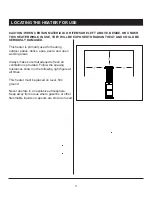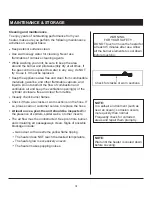
The installation must conform with local codes
or, in the absence of local codes, with
National Fuel Gas Code, ANSI Z223.1/NFPA 54,
NFPA58 Natural Gas and Propane Installation
Code, CSA B149.1, or Propane Storage and
Handling Code, B149.2.
The heater, when installed, must be electrically
grounded in accordance with local codes or, in
the absence of local codes, with National
Electrical Code, ANSI/NFPA 70, or Canadian
Electrical Code, CSA C22.1.
Children and adults should be alerted to
the hazards of high surface temperatures
and should stay away to avoid burns or
clothing ignition.
Children should be carefully
supervised when they are in the area of
the heater.
Clothing or other flammable materials
should not be hung from , placed on, or
near the heater.
Prior to use, check for damaged parts such as
hoses, regulators, pilot, or burner.
All leak tests should be done with a soapy solu-
tion. NEVER USE AN OPEN FLAME TO
CHECK FOR LEAKAGE.
The propane hose with the regulator assembly
shall be located out of pathways where people
may trip over it or in areas where the hose will not
be subject to accidental damage.
Any guard or other protective device
removed for servicing the heater must be
replaced prior to operating the heater.
Installation and repair should be done by
a qualified service person. The heater
should be inspected before use and at
least annually by a qualified service
person.
More frequent cleaning may be required
asnecessary. It is imperative that the control
compartment, burners , and circulating air
passageways of the heater be kept clean.
Keep the appliance area clear and free from
combustible materials,gasoline,andotherflam-
mable vapours and liquids.
Do not obstruct the flow of combustion and venti-
lation air.
Keep the ventilation opening(s) of the cylin-
der enclosure free and clear from debris.
This appliance shall be used only in a well-
ventilated space and shall not be used in a build-
ing, garage, or any other enclosed area.
An appliance may be installed with a shelter no
more inclusive than:
With walls on all sides, but with no overhead
cover.
Within a partial enclosure, which includes an
overhead cover and no more than two side
walls. These side walls may be parallel, as in a
breezeway, or at right angles to each other.
NOTE: PLEASE READ THE FOLLOWING SAFETY RULES.
WARNING:
WARNINGS AND CAUTIONS
3



















